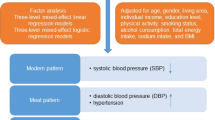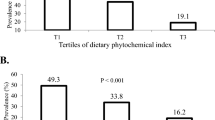Abstract
Background/objectives
Although previous in vivo and in vitro studies have reported the beneficial effects of phytochemical-rich food on cardiovascular health, limited information is available regarding its’ health effect on the community-dwelling population. This is especially true in Korea. Here, we examined the cross-sectional association between phytochemical levels and hypertension in Korean adults.
Subjects/methods
We analyzed data from 38,198 Koreans aged ≥30 years who participated in the Korea National Health and Nutrition Examination Survey (2008–2019) and met the study’s inclusion criteria. The Korean version of the Phytochemical Index (PI) was computed based on 24 h recall data. Hypertension was defined based on the American College of Cardiology/American Heart Association definition in 2017. Multivariate logistic regression analysis was used to examine the association between PI and hypertension.
Results
In the multivariable adjusted model, participants in the highest PI quintile had a significantly low prevalence of hypertension (Odd ratio, 0.86; 95% confidence interval, 0.79–0.95). A dose-response analysis confirmed the inverse linearity between PI and hypertension (p for nonlinearity = 0.2634).
Conclusions
Consumption of phytochemical-rich foods may lower the prevalence of hypertension. A large-scale, prospective cohort study is required to validate these findings.
This is a preview of subscription content, access via your institution
Access options
Subscribe to this journal
Receive 12 print issues and online access
$259.00 per year
only $21.58 per issue
Buy this article
- Purchase on Springer Link
- Instant access to full article PDF
Prices may be subject to local taxes which are calculated during checkout

Similar content being viewed by others
References
World health Organization. The top 10 causes of death. Geneva, Switzerland. World Health Organization. 2020. https://www.who.int/news-room/fact-sheets/detail/the-top-10-causes-of-death.
World Health Organization. Global atlas on cardiovascular disease prevention and control. Geneva, Switzerland. World Health Organization. 2011. http://apps.who.int/iris/handle/10665/44701.
Statistics Korea. Estimating the future population (2020–2070). Daejeon, Korea. Statistics Korea. 2021. https://www.kostat.go.kr/portal/korea/kor_nw/1/2/6/index.board?bmode=read&bSeq=&aSeq=415453&pageNo=1&rowNum=10&navCount=10&currPg=&searchInfo=&sTarget=title&sTxt=.
The Korean Society of Hypertension. Hypertension FACT SHEET 2021. Seoul, Korea. The korean Society of Hypertension. 2021. http://www.koreanhypertension.org/reference/guide?mode=read&idno=4581.
Statistics Korea. Statistics on the cause of death in 2020. Daejeon, Korea. Statistics Korea. 2021. https://www.kostat.go.kr/portal/korea/kor_nw/1/6/2/index.board?bmode=read&bSeq=&aSeq=403046&pageNo=1&rowNum=10&navCount=10&currPg=&searchInfo=&sTarget=title&sTxt=.
Guzik TJ, Touyz RM. Oxidative stress, inflammation, and vascular aging in hypertension. Hypertension. 2017;70:660–7.
Miranda AM, Steluti J, Fisberg RM, Marchioni DM. Association between Polyphenol Intake and Hypertension in Adults and Older Adults: a Population-Based Study in Brazil. PLoS One. 2016;11:e0165791.
Borgi L, Muraki I, Satija A, Willett WC, Rimm EB, Forman JP. Fruit and Vegetable Consumption and the Incidence of Hypertension in Three Prospective Cohort Studies. Hypertension. 2016;67:288–93.
Liu MW, Yu HJ, Yuan S, Song Y, Tang BW, Cao ZK, et al. Association between fruit and vegetable intake and the risk of hypertension among Chinese adults: a longitudinal study. Eur J Nutr. 2018;57:2639–47.
Golzarand M, Bahadoran Z, Mirmiran P, Sadeghian-Sharif S, Azizi F. Dietary phytochemical index is inversely associated with the occurrence of hypertension in adults: a 3-year follow-up (the Tehran Lipid and Glucose Study). Eur J Clin Nutr. 2015;69:392–8.
Utsugi MT, Ohkubo T, Kikuya M, Kurimoto A, Sato RI, Suzuki K, et al. Fruit and vegetable consumption and the risk of hypertension determined by self measurement of blood pressure at home: the Ohasama study. Hypertension Res. 2008;31:1435–43.
Kim M, Park K. Association between phytochemical index and metabolic syndrome. Nutr Res Pract. 2020;14:252–61.
Organization for Economic Cooperation and Development. Health at a Glance 2019 Paris, France. Organization for Economic Cooperation and Development indicators. 2019. https://www.oecd-ilibrary.org/social-issues-migration-health/health-at-a-glance-2019_4dd50c09-en.
Im J, Kim M, Park K. Association between the Phytochemical Index and Lower Prevalence of Obesity/Abdominal Obesity in Korean Adults. Nutrients. 2020;12:2312.
Kweon S, Kim Y, Jang M-J, Kim Y, Kim K, Choi S, et al. Data resource profile: the Korea national health and nutrition examination survey (KNHANES). Int J Epidemiol. 2014;43:69–77.
Korea Disease Control and Prevention Agency. The seventh Korea National Health and Nutrition Examination Survey (KNHANES VII-3). Cheongju, Korea. Korea center for Disease Control and Prevention. 2018. https://knhanes.kdca.go.kr/knhanes/sub03/sub03_02_05.do.
Willett W, Stampfer MJ. Total energy intake: implications for epidemiologic analyses. Am J Epidemiol. 1986;124:17–27.
Faul F, Erdfelder E, Lang A-G, Buchner A. G* Power 3: A flexible statistical power analysis program for the social, behavioral, and biomedical sciences. Behav Res Methods. 2007;39:175–91.
Faul F, Erdfelder E, Buchner A, Lang A-G. Statistical power analyses using G* Power 3.1: Tests for correlation and regression analyses. Behav Res Methods. 2009;41:1149–60.
Ainsworth BE, Haskell WL, Leon AS, Jacobs DR Jr, Montoye HJ, Sallis JF, et al. Compendium of physical activities: classification of energy costs of human physical activities. Med Sci Sports Exerc. 1993;25:71–80.
World Health Organization. The Asia-Pacifi perspective redefining obesity and its treatment. Geneva, Switzerland. World Health Organization. 2000. https://apps.who.int/iris/handle/10665/206936.
Han M-R, Park YJ, Paik H-Y, Song Y. An iodine database for common Korean foods and the association between iodine intake and thyroid disease in Korean adults. Int J Thyroidol. 2015;8:170–82.
McCarty MF. Proposal for a dietary “phytochemical index”. Med Hypotheses. 2004;63:813–7.
Korea Disease Control and Prevention Agency. Guidelines for Examination and Inspection (2016–2018). Cheongju, Korea. Korea Disease Control and Prevention Agency. 2016. https://knhanes.kdca.go.kr/knhanes/sub04/sub04_02_02.do?classType=4.
Ihm SH, Bakris G, Sakuma I, Sohn IS, Koh KK. Controversies in the 2017 ACC/AHA Hypertension Guidelines: Who Can Be Eligible for Treatments Under the New Guidelines?- An Asian Perspective. Circ J. 2019;83:504–10.
Chobanian AV, Bakris GL, Black HR, Cushman WC, Green LA, Izzo JL Jr, et al. The seventh report of the joint national committee on prevention, detection, evaluation, and treatment of high blood pressure: the JNC 7 report. JAMA. 2003;289:2560–72.
Bryan W, Giuseppe M, Wilko S, Enrico AR, Michel A, Michel B, et al. 2018 ESC/ESH Guidelines for the management of arterial hypertension. Rev Espanola de Cardiologia (Engl ed). 2019;72:160.
The Korean Society of Hypertension. Standard education slide for hypertension (for professionals). Seoul, Korea. The Korean Society of Hypertension. 2020. http://www.koreanhypertension.org/reference/guide?mode=read&idno=4361.
Huang Y, Cai X, Li Y, Su L, Mai W, Wang S, et al. Prehypertension and the risk of stroke: a meta-analysis. Neurology. 2014;82:1153–61.
Son JS, Choi S, Kim K, Kim SM, Choi D, Lee G, et al. Association of Blood Pressure Classification in Korean Young Adults According to the 2017 American College of Cardiology/American Heart Association Guidelines With Subsequent Cardiovascular Disease Events. JAMA. 2018;320:1783–92.
Whelton PK, Carey RM, Aronow WS, Casey DE Jr, Collins KJ, Dennison Himmelfarb C. et al. 2017 ACC/AHA/AAPA/ABC/ACPM/AGS/APhA/ASH/ASPC/NMA/PCNA Guideline for the Prevention, Detection, Evaluation, and Management of High Blood Pressure in Adults: Executive Summary: A Report of the American College of Cardiology/American Heart Association Task Force on Clinical Practice Guidelines. Hypertension. 2018;71:1269–324.
Asemu MM, Yalew AW, Kabeta ND, Mekonnen D. Prevalence and risk factors of hypertension among adults: A community based study in Addis Ababa, Ethiopia. PLoS One. 2021;16:e0248934.
Ozemek C, Laddu DR, Arena R, Lavie CJ. The role of diet for prevention and management of hypertension. Curr Opin Cardiol. 2018;33:388–93.
Grillo A, Salvi L, Coruzzi P, Salvi P, Parati G. Sodium intake and hypertension. Nutrients. 2019;11:1970.
Ramezankhani A, Azizi F, Hadaegh F. Associations of marital status with diabetes, hypertension, cardiovascular disease and all-cause mortality: a long term follow-up study. PLoS One. 2019;14:e0215593.
Liu RH. Health-promoting components of fruits and vegetables in the diet. Adv Nutr. 2013;4:384S–92S.
Locke A, Schneiderhan J, Zick SM. Diets for health: goals and guidelines 2018. Am Fam Physician. 2018;97:721–728.
Most MM. Estimated phytochemical content of the dietary approaches to stop hypertension (DASH) diet is higher than in the Control Study Diet. J Am Diet Assoc. 2004;104:1725–7.
Bagetta D, Maruca A, Lupia A, Mesiti F, Catalano R, Romeo I, et al. Mediterranean products as promising source of multi-target agents in the treatment of metabolic syndrome. Eur J Med Chem. 2020;186:111903.
Kim J, Kim J. Association between fruit and vegetable consumption and risk of hypertension in middle-aged and older Korean adults. J Acad Nutr Diet. 2018;118:1438–1447.e5.
Li B, Li F, Wang L, Zhang D. Fruit and vegetables consumption and risk of hypertension: a meta‐analysis. J Clin Hypertens (Greenwich). 2016;18:468–76.
Galleano M, Pechanova O, G Fraga C. Hypertension, nitric oxide, oxidants, and dietary plant polyphenols. Curr Pharm Biotechnol. 2010;11:837–48.
Cassidy A, O’Reilly ÉJ, Kay C, Sampson L, Franz M, Forman J, et al. Habitual intake of flavonoid subclasses and incident hypertension in adults. Am J Clin Nutr. 2011;93:338–47.
Rivas AM, Pena C, Kopel J, Dennis JA, Nugent K. Hypertension and hyperthyroidism: association and pathogenesis. Am J Med Sci. 2021;361:3–7.
Grennan D, Wang S. Steroid side effects. JAMA. 2019;322:282.
Chi JH, Lee BJ. Risk factors for hypertension and diabetes comorbidity in a Korean population: a cross-sectional study. PLoS One. 2022;17:e0262757.
Acknowledgements
The data examined in this study were obtained from the Korea National Health and Nutrition Examination Survey, National Research Institute of Health, Korea Disease Control and Prevention Agency, Ministry of Health and Welfare, Republic of Korea.
Funding
This research was supported by the National Research Foundation of Korea (NRF) (grant number: NRF-2021R1A2C1007869). The funding sponsors had no role in the study design, data collection, data analyses, data interpretation, writing of the paper, or decision to publish the results.
Author information
Authors and Affiliations
Contributions
UJ contributed to writing the original draft, formal analysis, visualization, and software. KP contributed to the conceptualization, supervision, project administration, resources, funding acquisition, validation, and discussion and edited the paper. All authors read and agreed to the final version of the paper.
Corresponding author
Ethics declarations
Competing interests
The authors declare no competing interests.
Ethics approval
The present study was approved by the institutional review boards of the Korea Disease Control and Prevention Agency (approval numbers: 2008-04EXP-01-C, 2009-01CON-03-2C, 2010-02CON-21-C, 2011-02CON-06-C, 2012-01EXP-01-2C, 2013-07CON-03-4C, 2013-12EXP-03-5C, 2018-01-03-P-A, and 2018-01-03-C-A). Korea National Health and Nutrition Examination Survey (KNHANES) 2015–2017 was conducted without ethical review according to the opinion of the Research Ethics Review Committee of the Korea Disease Control and Prevention Agency.
Additional information
Publisher’s note Springer Nature remains neutral with regard to jurisdictional claims in published maps and institutional affiliations.
Rights and permissions
About this article
Cite this article
Jo, U., Park, K. Phytochemical index and hypertension in Korean adults using data from the Korea National Health and Nutrition Examination Survey in 2008–2019. Eur J Clin Nutr 76, 1594–1599 (2022). https://doi.org/10.1038/s41430-022-01155-w
Received:
Revised:
Accepted:
Published:
Issue Date:
DOI: https://doi.org/10.1038/s41430-022-01155-w



